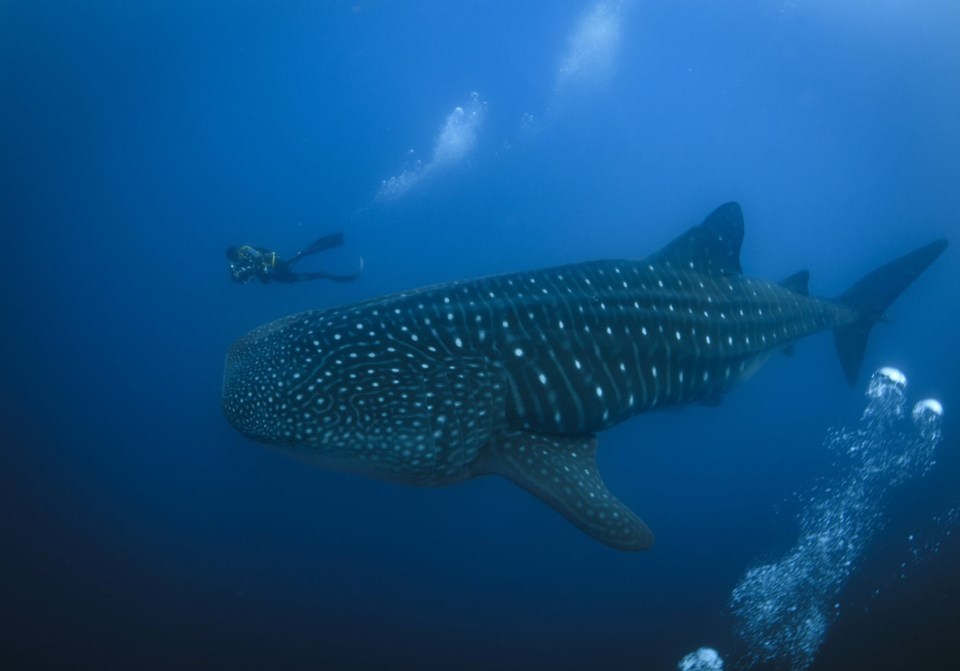GALûPAGOS ISLANDS, Ecuador (AP) ã Warm morning light reflects from the remains of a natural rock arch near Darwin Island, one of the most remote islands in the Galapagos. In clear, deep blue water, thousands of creatures ã fish, hammerhead sharks, marine iguanas ã move in search of food.
The 2021 collapse of Darwin's Arch, named for the famed British naturalist behind the theory of evolution, came from natural erosion. But its demise underscored the fragility of a far-flung archipelago that's coming under increased pressure both from and invasive species.
Warming oceans affect the food sources of many of the seagoing animals in the Galapagos. Marine iguanas ã one of many species that are endemic, or unique, to the Galapagos ã have a harder time finding the red and green algae they prefer. Sea turtles struggle to nest in warmer temperatures. Raising young gets harder as water warms and fewer nutrients are available.
While the Galapagos are known for a great multitude of species, their numbers aren't unlimited.
"We have something of everything here ã thatãs why people say the Galapagos is so diverse ã but we have a small number of each thing,ã said Natasha Cabezas, a naturalist guide.
The Galapagos have always been sensitive to changes in ocean temperature. The archipelago itself is located where major ocean currents converge ã cool from the south, warm from the north, and a cold upwelling current from the west. Then there's El Nino, the periodic and natural Pacific Ocean warming that affects weather worldwide.
While temperatures vary depending on the season and other naturally-occurring climate events, ocean temperatures have been rising because of human-caused climate change as oceans absorb the vast majority of excess heat in the atmosphere. The ocean experienced its warmest decade since at least the 1800s in the last 10 years, and 2023 was the .
Early June brings winter in the Southern Hemisphere, and the Cromwell current brings whale sharks, hammerheads, and massive sunfish to the surface. It also provides nutrients for penguins, marine iguanas and sea lions in search of food. As more of those animals make themselves known this season, scientists are tracking how they fared in the warming of the .
El Nino can bring food shortages for some species like marine iguanas and sea turtles, as the warmer ocean means dwindling food sources. Scientists observing the species have noted a significant decline in population numbers during El Nino events.
Marine iguanas swim like snakes through the water from rock to rock as waves crash against the shore of Fernandina Island. They latch themselves onto the undersea rocks to feed on algae growing there, while sea lions spin around them like puppies looking for someone to play with.
The iguanas were "one of the most affected species from El NiûÝo last year and right now they are still recovering,ã said Galapagos Conservancy Director Jorge Carriû°n.
As rising ocean temperatures threaten aquatic or seagoing life, on land there's a different problem. Feral animals ã cats, dogs, pigs, goats and cattle, none of them native ã are threatening the unique species of the islands.
After the COVID-19 pandemic, many people are abandoning the dogs and cats they wanted to keep them company, Cabezas said.
ãIf you donãt take care of them they become a problem and now itãs a shame to see dogs everywhere. We have a big problem right now I donãt know what weãre going to do,ã she said.
The non-native animals are a special threat to the giant tortoises closely associated with the Galapagos. The tortoises declined dramatically in the 19th century due to hunting and poaching, and authorities have worked to protect them from humans. It's been illegal to kill a giant tortoise since 1933.
ãIn one night, a feral pig can destroy all nesting sites in an area,ã Carriû°n said. Park rangers try to visit areas with nesting sites once a day, and kill pigs when they find them. But the pigs are elusive, Carrion said.
Feral cats feed on marine iguana hatchings, and both pigs and cats compete for food with the tortoises.
If invasive species and warming oceans weren't enough, there's the . reported microplastics in the bellies of Galapagos penguins.
ãThere are no animals in the Galapagos that do not have microplastics in their food,ã Carriû°n said.
___
The Associated Pressã climate and environmental coverage receives financial support from multiple private foundations. AP is solely responsible for all content. Find APãs for working with philanthropies, a list of supporters and funded coverage areas at .
Alie Skowronski, The Associated Press



